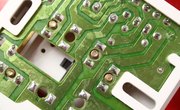
From the microphones at concerts to pH probes that test chemicals for acidity, you'll find transducers in a wide array of applications. The name transducer refers to any device that transforms mechanical phenomena into electrical phenomena or vice versa. This makes them pop up in many areas of life from radio antennae to earphones.
Transducer Examples
There are many ways to describe the different applications of transducers because there are so many ways of categorizing them. One general method that shows how they differ from one another is to compare how transducers convert energy and group them by this.
An example application of transducer conversion is a temperature transducer that converts temperature to an electric potential. This method of categorization is useful in telling you about what a type of transducer is used for.
Transducers can be photovoltaic, piezoelectric, chemical, mutual induction-based, electromagnetic, photoconductor-based or Hall effect-based. The photovoltaic transducer converts light into electrical energy. Piezoelectric transducers use the piezoelectric effect to convert mechanical stress into electrical energy. Chemical transducers convert chemical energy to other forms of energy.
Transducers that use mutual induction measure a quantity such as torque, force, velocity, linear displacement, pressure, acceleration or some other property and react with a change in inductance, the ability of a conductor to oppose an electrical current applied through it.
Electromagnetic transducers convert changes in magnetic field to electrical energy. Photoconductive transducers convert sunlight into electrical energy. Transducers that rely on the Hall effect (the production of a voltage difference across an electrical conductor) convert changes in magnetic field to electrical energy.
Some of these types of transducers have their applications in everyday appliances, like how piezoelectric transducers are used in electric cigarette lighters in which, when you press its button, a spring-loaded hammer strikes a piezoelectric crystal that creates a voltage across a spark gap to ignite gas.
Others are used in more large-scale projects such as the biggest torque transducer in the world, weighing in at 4.6 tonnes and measuring torques of up to 10MNm, by Datum Electronics.
Piezoelectric Effect Explained
You can find the piezoelectric effect in many materials, but it's important to differentiate them from sensors, one of their applications in transducers. Piezoelectric transducers fit material between two metal plates. The setup generates piezoelectricity when the material is pushed together. This converts the mechanical force of the push into electricity.
You can think of the piezoelectric material that is pressed together as a battery with a positive end and a negative end. The current flows if you connect the two faces of the battery in an electrical circuit.
The reverse is possible as well. If you were to induce an electric current across the material, it would undergo a mechanical stress pushing itself together, known as the reverse piezoelectric effect, and both the forward and reverse mechanisms are used in piezoelectric sensors.
Piezoelectric Transducer vs. Sensor Differences
Piezoelectric sensors differ from transducers in that they're a specific example of piezoelectric transducer that use a certain type of force transformed into an electrical energy that indicates some sort of observation has occurred. When you observe the piezoelectric effect in nature such as in natural sources of cane sugar, Berlinite and quartz, they can act as biological force sensors that can tell you whether a certain chemical reaction has been done as a result of the piezoelectric effect.
Similarly, piezoelectric sensors that engineers create can detect pressure variations in sound for use in microphones, pickups for electric guitar, medical imaging and industrial nondestructive testing. In contrast, piezoelectric actuators use the reverse piezoelectric effect to induce a mechanical stress in response to an applied electric current.
Electric dipole moments (the separation of positive and negative charges in a material) from the crystal lattice structures in materials, cause the piezoelectric effect to happen. As the materials are pressed together, dipoles line up in such a way that electric charge can flow.
Poling, a process in which a large electric field is used to align the regions of dipoles themselves, can be done to some piezoelectric materials to increase their efficiency. These piezoelectric materials need to have no center of symmetry because, if they did, the net charge would cancel out to zero and current couldn't flow.
Other Groupings of Transducer Examples
Because transducers are so broad with many applications, you can group them by other methods as well. Transducers can be sorted into the type of quantity they measure. There are transducers that measure temperature, pressure, displacement, force, flow and inductance.
Thermocouples measure temperature and output a specific electrical voltage based on it. Diaphragm transducers convert changes in pressure to small changes in displacement of a diaphragm. These use a material with microscopic holes that let water and hydroxyl ions or gases transport between the anode and cathode of an electric cell.
Application of diaphragm transducers
Strain gauges, devices that detect minute changes in electrical resistance when a mechanical force is applied to them, are a great example of an application of diaphragm transducers. They're used in balances as precise methods of measuring the mass of an object or materials placed on them. The strain gauges detect small changes in the size of the gauge in response to a resistance of an induced electrical current.
Strain gauges are built in a zigzag pattern on a backing that detects changes in resistance. The gauge factor represents this sensitivity to change and can be calculated as the change in resistance divided by the value of strain as δR/δS.
The wire is nominally of circular cross-section. As strain is applied to the gauge, the shape of the cross-section of the resistance wire distorts, changing the cross-sectional area. As the resistance of the wire per unit length is inversely proportional to the cross-sectional area, there is a consequential change in resistance.
The input–output relationship of a strain gauge is expressed by the gauge factor, which is defined as the change in resistance δR for a given value of strain δS, that is, gauge factor = δR/δS. The mechanisms behind the strain gauge, while similar to those of the piezoelectric effect, show how broad the applications in physics and engineering for transducers can be.
While they both convert mechanical energy to electrical energy, the piezoelectric effect relies mostly on the chemical composition of materials while the strain gauge uses the resistance in an electrical circuit.
Pressure Transducer Physics and Applications
A pressure transducer is another example of a strain gauge transducer. A pressure transducer uses a strain gauge made of silicon to calculate current that has a corresponding pressure and displacement of water level. For these types of transducers, 9.8 kPa of pressure correlates with 1 m of water height.
A pressure transducer typically uses vented cables to reduce the influence of atmospheric changes in pressure alongside a digital data logger for continuous data output that a scientist or engineer can easily analyze.
A general pressure transducer can also suffer from clogging as a result of iron hydroxide and other materials forming as precipitates, damage from acidic environments or corrosion due to gas for their uses in mining environments.
References
- Electrical 4 U: Transducer: Types of Transducers And What They Are
- Hyperphysics: Transducers
- CircuitGlobe: Photovoltaic or Solar Cell
- Electrical 4 U: Inductive Transducer
- Electrical Voice: Inductive Transducers Working Principles and Applications
- Amiraj College of Engineering: Electro Magnetic Transducers
- Automation Forum: Different types of Photoelectric transducers
- Scientific American: How do Hall effect transducers work?
- Datum Electronics: The biggest Torque Transducer in the World: Datum Electronics has gone Big
- Electronic Design: What is the Piezoelectric Effect?
- University of Cambridge: The piezoelectric dipole moment
- Sciencedirect: Transducers
- Sciencedirect: Diaphragm Pressure Sensor
About the Author
S. Hussain Ather is a Master's student in Science Communications the University of California, Santa Cruz. After studying physics and philosophy as an undergraduate at Indiana University-Bloomington, he worked as a scientist at the National Institutes of Health for two years. He primarily performs research in and write about neuroscience and philosophy, however, his interests span ethics, policy, and other areas relevant to science.
